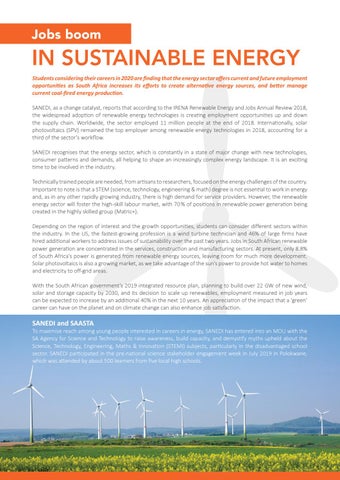Jobs boom
IN SUSTAINABLE ENERGY Students considering their careers in 2020 are finding that the energy sector offers current and future employment opportunities as South Africa increases its efforts to create alternative energy sources, and better manage current coal-fired energy production. SANEDI, as a change catalyst, reports that according to the IRENA Renewable Energy and Jobs Annual Review 2018, the widespread adoption of renewable energy technologies is creating employment opportunities up and down the supply chain. Worldwide, the sector employed 11 million people at the end of 2018. Internationally, solar photovoltaics (SPV) remained the top employer among renewable energy technologies in 2018, accounting for a third of the sector’s workflow. SANEDI recognises that the energy sector, which is constantly in a state of major change with new technologies, consumer patterns and demands, all helping to shape an increasingly complex energy landscape. It is an exciting time to be involved in the industry. Technically trained people are needed, from artisans to researchers, focused on the energy challenges of the country. Important to note is that a STEM (science, technology, engineering & math) degree is not essential to work in energy and, as in any other rapidly growing industry, there is high demand for service providers. However, the renewable energy sector will foster the high-skill labour market, with 70 % of positions in renewable power generation being created in the highly skilled group (Matric+). Depending on the region of interest and the growth opportunities, students can consider different sectors within the industry. In the US, the fastest-growing profession is a wind turbine technician and 46% of large firms have hired additional workers to address issues of sustainability over the past two years. Jobs in South African renewable power generation are concentrated in the services, construction and manufacturing sectors. At present, only 8.8% of South Africa’s power is generated from renewable energy sources, leaving room for much more development. Solar photovoltaics is also a growing market, as we take advantage of the sun’s power to provide hot water to homes and electricity to off-grid areas. With the South African government’s 2019 integrated resource plan, planning to build over 22 GW of new wind, solar and storage capacity by 2030, and its decision to scale up renewables, employment measured in job years can be expected to increase by an additional 40% in the next 10 years. An appreciation of the impact that a ‘green’ career can have on the planet and on climate change can also enhance job satisfaction.
SANEDI and SAASTA
To maximise reach among young people interested in careers in energy, SANEDI has entered into an MOU with the SA Agency for Science and Technology to raise awareness, build capacity, and demystify myths upheld about the Science, Technology, Engineering, Maths & Innovation (STEMI) subjects, particularly in the disadvantaged school sector. SANEDI participated in the pre-national science stakeholder engagement week in July 2019 in Polokwane, which was attended by about 500 learners from five local high schools.
24
WORKING FOR ENERGY






